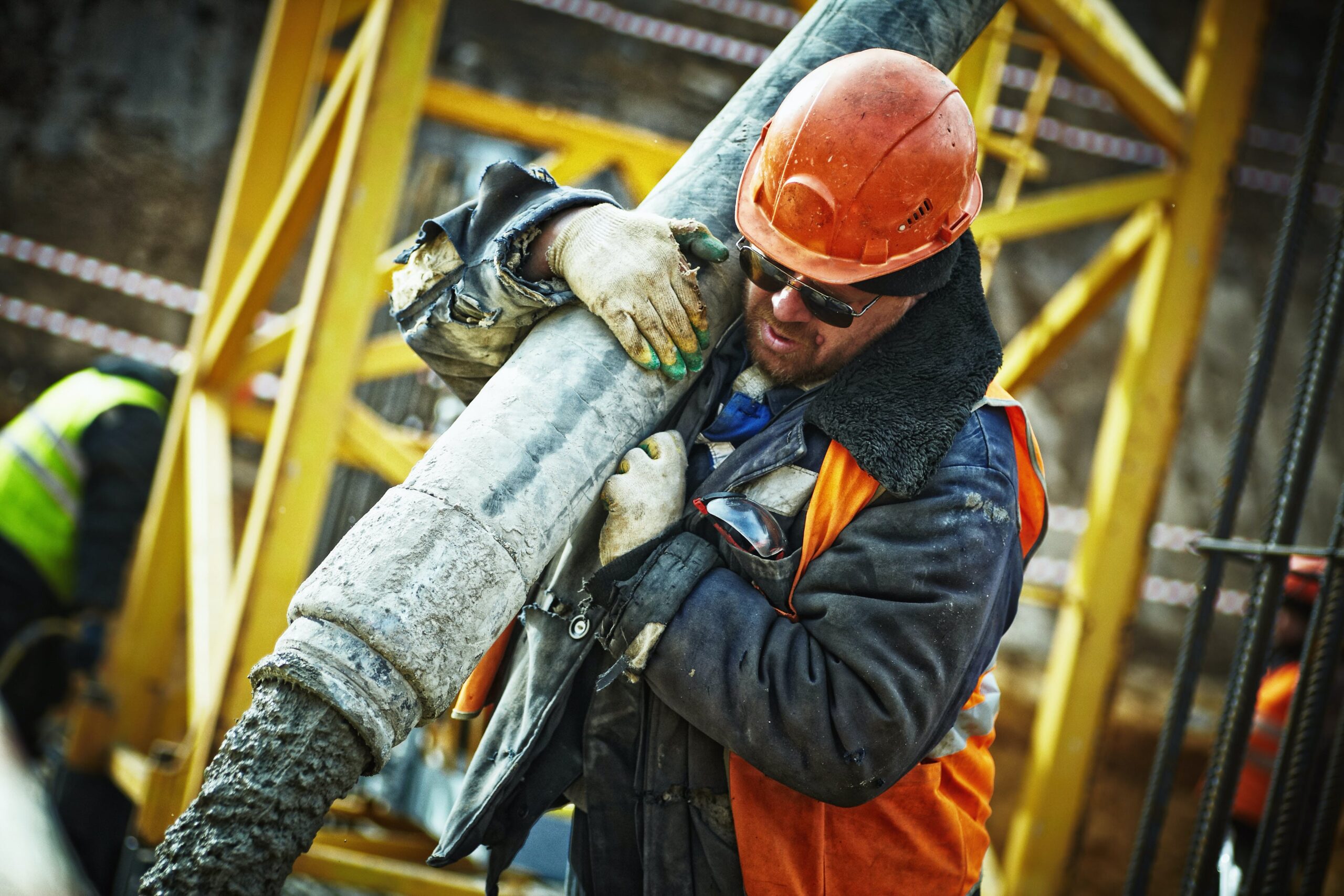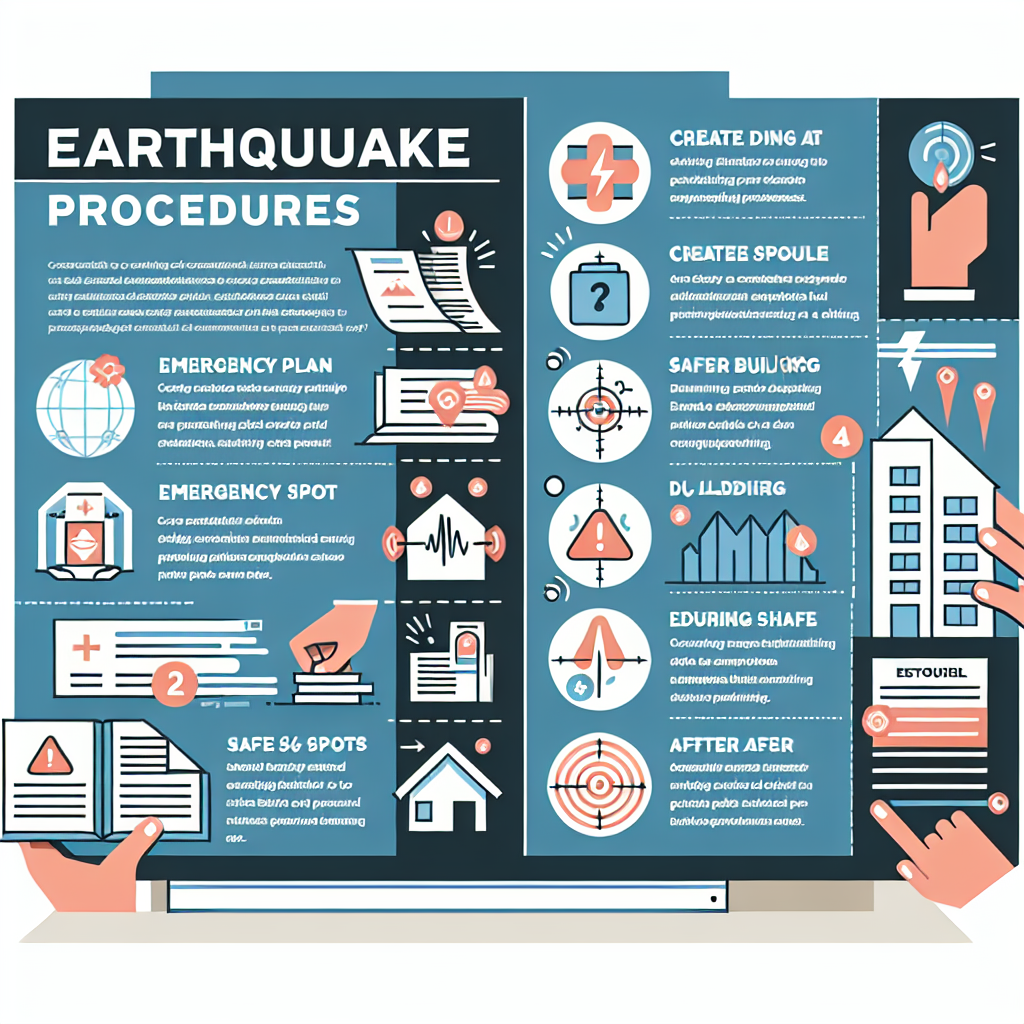Are you prepared for an earthquake? Knowing what to do in the event of an earthquake is crucial to ensuring your safety and that of those around you. In this article, we will guide you through the essential earthquake procedures that everyone should be familiar with. From creating a family emergency plan to identifying safe spots in your home or workplace, we will equip you with the knowledge and confidence needed to mitigate the risks and navigate through this natural disaster. So, let’s get started and empower you with the necessary skills to protect yourself when the earth trembles.
Earthquake Procedures
Earthquakes are natural phenomena that can cause significant destruction and pose a threat to human lives. It is crucial to understand earthquake procedures and be prepared to minimize the risks associated with these seismic events. This comprehensive article will guide you through every step of earthquake preparedness and response, ensuring your safety and the safety of your loved ones.

Understanding Earthquakes
Definition and Causes
An earthquake is a sudden shaking or trembling of the ground caused by the movement of tectonic plates beneath the Earth’s surface. This movement occurs along fault lines where stress and pressure build up over time. When this pressure is released, it results in seismic waves that cause the ground to shake.
Common Magnitude Scales
To measure an earthquake’s strength, scientists use magnitude scales, with the Richter scale being the most commonly known. The Richter scale measures the amplitude of seismic waves recorded by seismographs. Another common scale is the Moment Magnitude Scale (MMS), which estimates the total energy released by an earthquake.
Seismic Waves
Seismic waves are the energy waves generated by an earthquake. There are three primary types of seismic waves: P-waves, S-waves, and surface waves. P-waves are the fastest and first to arrive, while S-waves follow shortly after. Surface waves cause the most damage as they travel along the Earth’s surface.
Epicenter and Focus
The epicenter is the point on the Earth’s surface directly above the focus, which is the location deep within the Earth where the earthquake originates. Understanding these terms is crucial when assessing earthquake impacts and determining the affected area.
Earthquake Zones and Fault Lines
Earthquakes occur in certain areas known as earthquake zones. These zones are primarily located along fault lines, where tectonic plates meet. The Pacific Ring of Fire is the most active earthquake zone globally, being susceptible to frequent seismic activity.
Preparing Before an Earthquake
Assessing Risks
Before an earthquake strikes, it is important to assess the risks specific to your location. Consult local geological surveys and research historical earthquake data to determine the likelihood and potential intensity of earthquakes in your area. This information will help you make informed decisions about preparation measures.
Home Safety Measures
Securing your home is essential in minimizing the risks during an earthquake. Reinforcing the structural integrity of your house by consulting a professional contractor and ensuring compliance with seismic building codes is crucial. Additionally, securing heavy objects, such as bookshelves and appliances, to the walls will prevent them from toppling during shaking.
Securing Heavy Objects
Heavy objects, such as furniture and electronic appliances, can become hazards during an earthquake. Secure them by attaching brackets or straps to walls or floors. By doing so, you will prevent them from shifting or toppling during the shaking, reducing the risk of injury.
Creating a Family Communication Plan
Developing a family communication plan is essential so that everyone knows how to find each other in the event of an earthquake. Determine specific meeting points both within and outside your house. Additionally, designate an out-of-area contact person whom everyone can reach to provide updates on their safety.
Identifying Community Resources
Familiarize yourself with community resources and emergency services available in your area. Find out the location of nearby hospitals, shelters, and designated evacuation areas. This knowledge will help you make informed decisions during an earthquake and enable you to access necessary assistance promptly.
During an Earthquake
Drop, Cover, and Hold On
When the ground starts shaking during an earthquake, remember to “Drop, Cover, and Hold On.” Drop down to the ground to prevent being knocked over by shaking. Take cover under a sturdy piece of furniture, such as a table or desk, to protect yourself from falling objects. Hold on to the furniture and stay in place until the shaking stops.
Protecting Yourself Indoors
If you are indoors during an earthquake and can’t reach a sturdy piece of furniture, take cover against an interior wall or in a doorway. Protect your head and neck with your arms or a pillow. Stay away from windows, glass, and any potentially hazardous objects that may fall.
Protecting Yourself Outdoors
If you are outdoors, move to an open area away from buildings, trees, streetlights, and utility wires. Drop down to the ground to avoid being knocked over by the shaking. Cover your head and neck with your arms to protect yourself from falling debris. Stay in this position until the shaking stops.
Safety Tips for Different Locations
Different locations require different safety precautions during an earthquake. In high-rise buildings, avoid using elevators and take cover against an interior wall or under a desk. If you are in a vehicle, pull over to a safe location away from overpasses, bridges, and power lines. Stay inside the vehicle until the shaking stops.
Evacuation Considerations
In some cases, evacuation may be necessary during or after an earthquake. If authorities advise evacuation, follow their instructions and proceed to designated evacuation routes and assembly points. Bring your emergency kit with you and prioritize safety above all else.
After an Earthquake
Checking for Injuries
Once the shaking stops, check yourself and others for injuries. Attend to any medical needs immediately and provide basic first aid as necessary. If someone is severely injured, call emergency services and provide them with clear and concise information about the situation.
Assessing Structural Damage
Inspect your surroundings for any signs of structural damage. If you notice cracks in walls, ceilings, or foundations, or if the building seems unstable, evacuate immediately. Structural damage can pose a significant risk, and it is crucial to prioritize your safety above all else.
Safely Exiting Damaged Buildings
If you need to leave a damaged building, do so in a cautious and safe manner. Be mindful of potential hazards, such as falling objects or unstable structures. Exit through designated evacuation routes, and avoid using elevators. Once outside, move to an open area away from buildings and other potential hazards.
Utility Shutdown and Gas Leaks
In the aftermath of an earthquake, it is essential to shut off utilities to prevent further damage and potential hazards. Familiarize yourself with the location of main utility switches and shut them off if necessary. If you smell gas or suspect a gas leak, evacuate immediately and alert the appropriate authorities.
Search and Rescue Operations
In the event of a severe earthquake, search and rescue operations may be necessary to locate and assist individuals who may be trapped or injured. If you come across someone who needs help, provide basic first aid if you are trained to do so. Otherwise, call emergency services and provide them with the necessary information.

Creating an Emergency Kit
Food and Water Supplies
Prepare an emergency kit that includes a supply of non-perishable food items and clean drinking water. Aim for at least three days’ worth of supplies per person. Choose items that are easy to store and have a long shelf life. Consider any specific dietary needs when selecting food items.
First Aid Kit
A well-stocked first aid kit is crucial in providing immediate medical care during and after an earthquake. Include supplies such as bandages, antiseptic solution, adhesive tape, pain relievers, and any necessary prescription medications. Additionally, include a first aid manual to guide you through emergency medical procedures.
Emergency Tools
Include essential emergency tools in your kit, such as a flashlight, batteries, a portable radio, and a multipurpose tool with a knife. These tools will come in handy during power outages and other emergency situations. Make sure to check the batteries in your flashlight regularly to ensure they are in working condition.
Extra Clothing and Blankets
Pack extra clothing and blankets to keep you warm during and after an earthquake. Choose clothing suitable for the weather conditions in your area and include sturdy shoes. Blankets will provide comfort and insulation in case of a loss of heating or during outdoor evacuations.
Important Documents
Make copies of important documents, such as identification cards, insurance policies, and medical records, and place them in a waterproof, portable container. Having these documents readily accessible will simplify the process of filing insurance claims or addressing any legal matters that may arise after an earthquake.
Developing an Emergency Plan
Identifying Assembly Points
Designate assembly points both within and outside your home. These points will serve as meeting places for your family in case of an earthquake. Ensure that every family member is aware of these locations and knows how to reach them safely.
Designating Responsibilities
Assign specific responsibilities to each family member to ensure a coordinated response during an earthquake. For example, one family member may be responsible for shutting off utilities, while another may be in charge of grabbing the emergency kit. Clearly communicate these responsibilities and ensure everyone understands their roles.
Communication Protocols
Establish communication protocols for your family in case of an earthquake. Decide on a single point of contact outside the affected area whom everyone can contact to provide updates on their safety. Consider utilizing mobile phones, walkie-talkies, or social media platforms to facilitate communication during times of crisis.
Evacuation Routes
Identify and familiarize yourself with evacuation routes in your area. Determine more than one route in case one becomes inaccessible due to damage or congestion. Regularly practice evacuating along these routes to ensure everyone knows the way and can follow the plan seamlessly during an actual emergency.
Special Considerations for Elderly or Disabled
If you have elderly or disabled family members, take their specific needs into consideration when developing your emergency plan. Ensure that their mobility aids and necessary medications are easily accessible. Plan for any additional assistance they may require and include it in your emergency plan.

Securing Buildings and Furniture
Reinforcing Structural Weak Points
Consult with a professional contractor to assess and reinforce any structural weak points in your home. This may include reinforcing walls, roofs, or foundations. Strengthening these areas will enhance your home’s resistance to earthquake forces and minimize the risk of collapse or significant damage.
Anchoring Heavy Furniture and Appliances
Secure heavy furniture and appliances to the walls or floors using brackets or straps. Anchoring these items will prevent them from shifting or toppling during an earthquake, reducing the risk of injury or damage. Pay special attention to large items such as bookshelves, cabinets, and entertainment centers.
Bracing Tall Bookshelves
Tall bookshelves are particularly susceptible to toppling during an earthquake. Install braces or brackets to attach these shelves securely to walls. It is essential to distribute the weight of items on the shelves evenly and avoid placing heavy objects on the top shelves.
Securing Cabinets and Drawers
Cabinets and drawers can open and spill their contents during an earthquake, potentially causing injuries. Use latches or childproof locks to secure them and prevent them from opening. Regularly check these safety measures to ensure they are in good working condition.
Protecting Windows and Glass
Reinforce windows and glass areas to reduce the risk of shattering during an earthquake. Apply window film or use safety glass that is designed to withstand seismic forces. Additionally, use safety film or adhesive strips to secure mirrors or glass frames hanging on walls.
Identifying Safe Spaces
Criteria for Safe Spaces
Identifying safe spaces within your home or workplace is crucial for sheltering during an earthquake. These spaces should meet certain criteria including being structurally sound, away from windows, and free from potential falling objects. Safe spaces should also be easily accessible and provide enough room for everyone present.
Identifying Shelter-In-Place Locations
For some earthquakes, it may be safer to stay where you are rather than attempting to evacuate. Designating shelter-in-place locations within your home or workplace is important. These spaces should offer protection from falling debris and have access to necessary supplies, such as your emergency kit.
Choosing Meeting Points
Identify meeting points both within and outside your immediate vicinity. These meeting points will be essential for reuniting with family members or coworkers after an earthquake. Choose easily identifiable locations and ensure that everyone knows how to reach these points quickly and safely.
Safe Spaces in Different Settings
Safe spaces may vary depending on your location during an earthquake. In a residential setting, safe spaces could include under sturdy tables or desks, or against interior walls. In a workplace or school, follow existing emergency evacuation plans and identify areas that offer protection from falling objects.
Emergency Kits in Safe Spaces
It is advisable to keep emergency kits in your identified safe spaces. This ensures that essential supplies are readily accessible during an earthquake. Include items such as flashlights, batteries, first aid supplies, and food and water provisions. Regularly check and replenish your emergency kits to maintain their effectiveness.

Responding to Earthquake Alarms
Staying Alert to Alarms
Earthquake alarms are essential in providing advance warning and allowing individuals to take cover before shaking begins. Stay alert to any earthquake alarm systems available in your area and familiarize yourself with their signals. They may be in the form of audible sirens, automated phone calls, or text alerts.
Understanding Alarm Response Actions
Understand the recommended response actions associated with earthquake alarms. These actions may include dropping, covering, and holding on, or immediately evacuating to a designated safe location. Familiarize yourself with the instructions provided by local authorities and respond accordingly to ensure your safety.
Following Official Guidance
In the event of an earthquake alarm, it is crucial to follow official guidance issued by local authorities. Take immediate action as directed, whether it involves seeking shelter or evacuating to a safe location. Remember, your safety depends on your timely and informed response to the alarm.
Drills and Training
Regular Earthquake Drills
Conducting regular earthquake drills is essential to reinforce preparedness and ensure a timely response during an actual earthquake. Practice drop, cover, and hold on procedures, evacuation routes, and communication protocols with your family or coworkers. Regular drills will help everyone become familiar with the necessary actions to take in case of an earthquake.
Training for First Aid and CPR
Knowledge of first aid and CPR (Cardiopulmonary Resuscitation) is invaluable during emergencies, including earthquakes. Consider undergoing training programs and courses to learn these life-saving skills. Knowing how to provide immediate medical assistance can make a significant difference in the outcome for injured individuals.
Participating in Community Exercises
Engaging in community exercises and drills enhances earthquake preparedness on a broader scale. Participate in local community exercises organized by emergency management agencies or community organizations. These exercises simulate earthquake scenarios and provide opportunities to practice response and coordination with various agencies.
Educating Children about Earthquake Procedures
Educating children about earthquake procedures is crucial in ensuring their safety and understanding. Teach them how to drop, cover, and hold on during an earthquake. Explain the importance of following evacuation plans and safe space identification. Use age-appropriate language and materials to engage their understanding and cooperation.
Staying Informed about Local Emergency Plans
Stay informed about local emergency plans and procedures specific to your area. Regularly check for updates and changes to evacuation routes, assembly points, or any other relevant information. Familiarize yourself with the emergency contact numbers and resources available in your community.
By following these earthquake procedures and guidelines, you can significantly reduce the risks and impacts associated with earthquakes. Remember, preparedness and awareness play a crucial role in ensuring your safety and the safety of those around you. Stay informed, be proactive, and always prioritize safety above all else.




